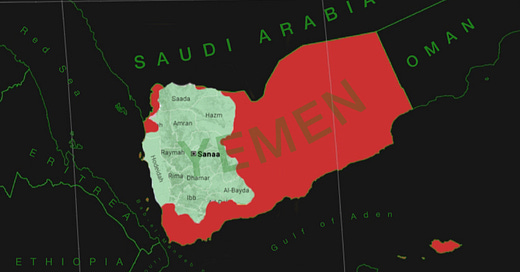Note from Lethal Minds:
Bulletin From The Borderlands is a joint project between Lethal Minds and some of the most talented OSINT analysts and independent journalists working today. Our goal is to provide you with a clear, accurate, and informative view of the world, free from censorship or bias. The Bulletin will bring you the facts, our analysis, and our evidence. We hope you find our work helps you better understand the complicated and increasingly volatile world in which we live.
Be informed, be prepared, be lethal.
Escalation In The Red Sea Part 1
The Houthi Threat
John M. Larrier-Defense Bulletin
Map showing Houthi controlled areas in Yemen.
Since the October 7th attacks on Israel by Hamas, the conflict has escalated and spread to the surrounding region. The tempo of attacks on U.S. bases and infrastructure by Iranian proxies across the region have increased, the Houthis have begun attacking naval and commercial shipping in the Red Sea, and the U.S. led framework struggles to keep tensions in the region from boiling over. In the meantime, Iran stokes the fires from the “sidelines”. With tensions in the Middle East at the highest they’ve been in decades, deterrence and the cause for escalation is once again on the minds of many. These two pieces will be short but detailed analyses of key points of escalation/failed deterrence in the region since October 7th, with a focus on events in the Red Sea. It will not prescribe recommendations for future actions.
In an earlier piece I wrote about how Iran has been content to combat not just Israel, but the United States, through its proxies instead of directly involving its conventional forces.
“Both Iran and Hezbollah have indicated that any increase in involvement from the U.S. will be met with increased involvement from Hezbollah and Iran itself. Hezbollah specifically has said that they will enter the ground war should Israel enter Gaza. There’s an argument to be made that the withdrawal of the Saudis was the mission of this attack and that Iran’s threshold for direct involvement is now much higher than it was before. So far Iran has benefited greatly from these attacks by killing the rapprochement process.”
-The Grey Zone Special Report: Hamas Attacks Israel. Retaliation or Iranian Stratagem?
(Alcon Intelligence and Lethal Minds Journal)
Who are the Houthis? The Houthis, formally known as Ansar Allah, are a Yemeni rebel group that originated from the Zaidi Shia Muslim minority. The movement was established in the early 2000s, initially driven by grievances over political and economic control, as well as religious discrimination against the aforementioned minority. The conflict escalated in 2014 when the Houthis took control of the Yemeni capital, Sanaa, leading to the ousting of the internationally recognized government. This triggered a military intervention in 2015 by a coalition led by Saudi Arabia and the United Arab Emirates, aimed at restoring the ousted government and countering Iranian influence within the Houthi command structure. The Houthi rebels, who are known to receive extensive financial and material support from Iran, employ asymmetrical warfare tactics, including guerrilla warfare, ballistic missile attacks, and drone strikes to realize their battlefield goals. They control significant territories in northern Yemen.
Like I highlighted before, Iran’s use of non-state actors to affect change in the region keeps the conflict below the threshold of conventional state on state warfare. The Houthis have now introduced a nuanced dynamic to the mix that the United States has struggled to adequately deal with. Keeping in mind how Iran operates in the region, the Houthis “entering the conflict” on the side of Hamas highlights the broader struggle for regional dominance between the U.S. and Iran as well as Saudi Arabia.
Since their declaration of war on Israel, citing the war in Gaza as justification, the Houthis have fired at and struck numerous commercial vessels in and around the Red Sea, and have vowed to continue carrying out these attacks as long as Israel continues its operation in Gaza. We now know this justification to be misleading at best. The Houthis have failed to relegate their strike campaign just to Israeli shipping, while simultaneously targeting the multinational naval presence in the waters in and around the Bab-al-Mandab Strait and the Gulf of Aden. One thing ought to be noted. While the Houthis are largely supplied and funded by Iran, there is some credence to the notion that they could overstep and exceed the expectations of the set out Iranian stratagems. The thought here is that by doing this they would induce an overwhelming U.S.-Coalition response to their actions. Unfortunately the U.S. seems reluctant to respond at all.
The United States, who has pledged its support for Israel in the eradication of Hamas, is the third most important player, save Iran, in the region. Directly after the attacks on October 7th, the U.S. massively increased its naval and ground based force posture in the CENTCOM AOR (Area of Responsibility). According to the current administration, this change in posture was meant to deter further escalation and expansion of the conflict in the region. So how have we gotten here?
The United States has responded to more than 100 attacks on U.S bases and infrastructure in the region with extremely limited strikes, and has so far failed to curb escalation in the region.
The failure to prevent the widening of the conflict underscores the complexity of the issues at hand and the limitations the current U.S. administration seems to have when it comes to combating current and emerging threats in the region. While the limited ability of the Houthis to project power compared to traditional state actors may seem less formidable, their asymmetric tactics and disruption of key maritime routes present a strategic challenge that the U.S. has so far failed to correctly combat.
Lethal Minds is a reader-supported publication.
Our monthly subscription is : $5
Our annual subscription is : $2.50 a month
Group subscriptions are available at a 25% discount per seat






